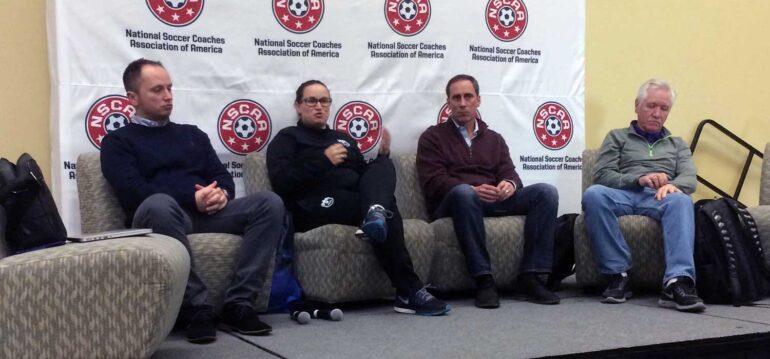On a Thursday afternoon at the 2016 NSCAA Convention in Baltimore, four head coaches from the National Women’s Soccer League (NWSL) sat down and explained the nuances of coaching in the NWSL, discussed some of the challenges that go along with the job, and offered suggestions for improving the league.
The panel included the Washington Spirit’s Jim Gabarra, Seattle Reign FC’s Laura Harvey, Portland Thorns FC’s Mark Parsons, and the Orlando Pride’s Tom Sermanni.
Gaining Experience
Gabarra took to the stage first and stressed how important it is to gain experience so you can better operate your team. He included an example of his days coaching in the USL W-League after the end of the Women’s United Soccer Association (WUSA). At that time, he wasn’t only coaching his team but also selling tickets, managing players’ on and off the field, running the team’s youth camps, and even doing the team’s laundry at one point. Gabarra explained how having experience in all of those roles helps him better understand player needs and wants and how to balance that aspect with what is best for the organization.
Selling the NWSL
Harvey’s video presentation consisted of player testimonials for the Reign. She explained how she uses video to market playing in the NWSL. Harvey said it’s a challenge to try and sell the NWSL to a non-American player for a number of reasons, including
- lack of overall familiarity with the league and
- stability, with former leagues in the United States folding.
Competition is the main selling point for her; in the NWSL, you have to show up every week to win matches. Every time a team takes to the field, you have to give it your all to get a result whereas in other leagues, you can afford to have an off-day and still get a result. And for Harvey, this a big reason why her overseas players came to Seattle — to play in “the most competitive league in the world.”
Creating Identity
Parsons, in his role with the Washington Spirit, said his main role was to create the right identity for the team. And that will be something he will continue with his new team, the Portland Thorns FC. He broke his philosophy down into three parts:
- Find the right people for the club. Finding play who will fit the type of game you want to play. For Parsons, if players “aren’t fully buying into that mindset, then there is no use for having them there.” And that not only has to be true of the players but also the coaches, trainers, and front office. In Parsons’s mind, if everyone buys into a single mindset, then everyone can do their jobs with the right amount of passion and belief in the organization’s goals.
- Set standards. Setting standards is crucial to creating the team’s identity. Coaches have to set the standards for how your team will train and play. Parsons said there is no “80 percent days or an off day.” You either train at and for peak performance or not at all.
- Be honest. Set a standard of honesty early. Let players know their roles with the club. In return, encourage players to be honest with you. Honest communication goes a long way in helping the team mold into what they want to become.
Looking Back
Finally, Sermanni, a first-year head coach in the NWSL with the Orlando Pride, said he looked at where the league is now in relation to the two prior women’s professional leagues in the United States for reference. For Sermanni, it’s about what the league can add to make it better and more appealing to top players. Some of those additions include
- continuing expansion,
- a domestic cup competition that involves lower-level teams,
- exploring the possibility of hosting a Women’s World Club Cup, and
- implementing special salary rules for top priority foreign internationals, similar to the Major League Soccer Designated Player rule, for example.
He did caution that some or all of these things may or may not happen — financial constraints and the current league calendar two reasons — but some things are definitely possible.
The coaches panel was a snapshot take on how a few NWSL coaches look at the league as it heads into it an unprecedented fourth season in 2016. It’s unchartered waters for any professional women’s soccer league based in the United States but there is room for optimism and opportunity for those involved with the league.

